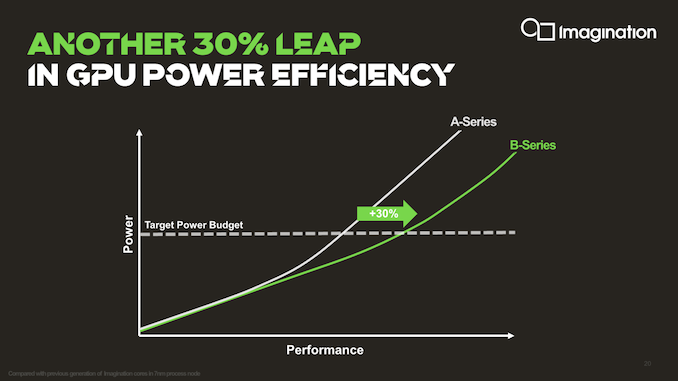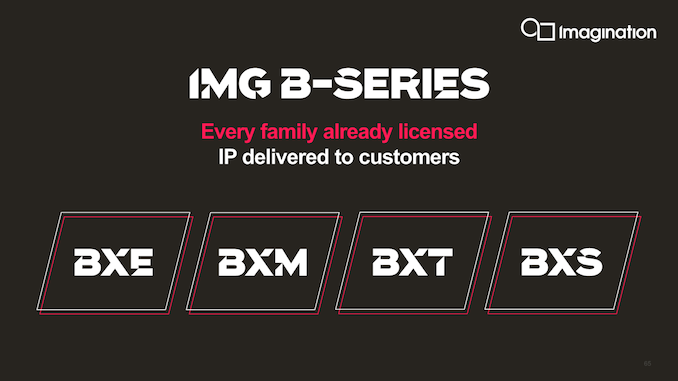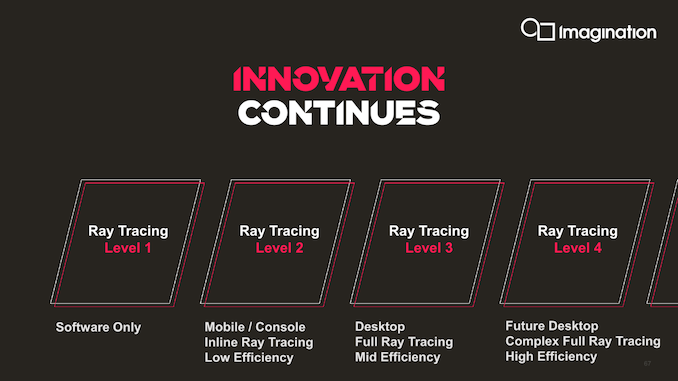Imagination Announces B-Series GPU IP: Scaling up with Multi-GPU
by Andrei Frumusanu on October 13, 2020 4:00 AM EST- Posted in
- GPUs
- Imagination Technologies
- SoCs
- IP
Performance, Efficiency, and a Raytracing Teaser
Overall, today’s announcement of the B-Series has been actually quite exciting. Although the actual GPU microarchitecture has seen only somewhat minor advancements compared to last year’s A-Series, Imagination’s take on multi-GPU is quite innovative and unlike what we’ve seen in past multi-GPU attempts.
The new “pull” decentralised GPU design is certainly something that offers tremendous flexibility. It won’t be something that has absolutely perfect scaling, as there might be some edge-cases where things might get bottlenecked, however Imagination expects extremely good scaling on average.
The B-Series’ roadmapped +30% performance improvement is said to have been achieved through both microarchitectural and physical design improvements (around 15%), with the rest being achieved through the PPA advantage of choosing a multi-core GPU configuration.
Probably what’s more important than the GPU IP itself, is that Imagination says they have actually licensed out and delivered the IP customers already – which is a contrast to past generation Imagination GPU IP announcements where things were publicised ahead of not only the IP being delivered, but ahead of it even being completed.
We still haven not seen or heard of any A-Series design wins, so we do hope there will be more news on that in regards to the B-Series.
Industry sources say that the major demand-driver for Imagination GPU IP right now is the high-performance GPU market in China, where there’s apparently a major hunger and need for domestic designs that are disconnected from US suppliers such as AMD and Nvidia.

Innosilicon Fantasy GPU Series
One such design win is Innosilicon’s recently announced “Fantasy” graphics cards series. Innosilicon to date was known as an ASIC IP design house for various miscellaneous IP blocks, such as providing Nivdia’s GDDR6’s memory controllers.
Roger Mao, Vice President of Engineering, Innosilicon, says;
“Imagination’s BXT multi-core GPU IP delivers the level of performance and power efficiency we had been looking for. Innosilicon has a solid track record in delivering first class high-speed and high-bandwidth computing solutions in advanced FinFET process nodes. Building on this success and strong customer demand, we are announcing our upcoming product which is a standalone high-performance 4K/8K PCI-E Gen4 GPU card, set to hit the market very soon, that will power 5G cloud gaming and data centre applications. With a solid foundation in GDDR6 high-speed memory, cache coherent chiplet innovation and high-performance multimedia processor optimisation, a move into a standalone PCI-E form-factor GPU is natural for us. Thanks to BXT’s multi-core scalable architecture, we are able to build a customised solution to meet the high-end data centre demand with fantastic cloud and computing performance.”
If this pivot towards higher-performance computing works out for Imagination remains to be seen. It certainly seems that at least having a tangible design win such as the above would certainly be a big improvement given that we’ve never seen publicly acknowledged 8XT, 9XT, 9XTP or even A-Series silicon.
Level 4 Raytracing for C-Series
Lastly, Imagination is also teasing their future C-Series architecture, confirming that it’ll be a full raytracing capable design. Although Imagination has had Raytracing IP and capable GPUs for the better part of the decade, it took Nvidia’s RTX series as well as AMD’s inclusion of Raytracing in the new generation consoles as well as RDNA2 series to seriously kick-start the RT ecosystem into gear. Imagination is taking full advantage of this revival as it dusted off its RT IP that previously had been shelved a few years ago.
Beyond confirming that the new C-Series will have ray tracing capabilities, Imagination further confirms that this will be an implementation using the company’s fullest of capabilities, including BVH processing and Coherency Sorting in hardware, a capability the company denotes as a “Level 4” ray tracing implementation, which would be more advanced than what current generation Nvidia and AMD GPUs are able to achieve at a “Level 3”.
Imagination explains that they’ve had these capabilities for a long time, and when discussing with customers as to what kind of capabilities they would like to see in future IP, they had chosen to go for the full-blown implementation as this was the better future-proof design choice.
Overall, it seems like Imagination is on a path where it tries to diversify itself to markets other than the typical low-power GPU use-cases. The next few years will definitely be interesting for the company, and particularly the new distributed multi-GPU approach will be something to pay attention to.














74 Comments
View All Comments
HVAC - Tuesday, October 13, 2020 - link
You don't win market share without a product offering in the market. If we only did things for which we could be certain of success, we would all still be huddled into a teeming mass near central Asia.EthiaW - Tuesday, October 13, 2020 - link
Since there has been no application of Imagination's top tier configurations after Apple abandoned them (from the Furian generation, 2017), leaving that market for small budget gpus, likely those in wearable devices will be justifiable.They having been working on high-end mobile gpus for some 5 years without market share, sadly.
Zingam - Wednesday, October 14, 2020 - link
This way of thinking, Mr.... that's why you are no Bill Gates.Yojimbo - Tuesday, October 13, 2020 - link
Because the Chinese have a lot of money to throw around and they desperately want to develop market-controlling technologies. They don't control that many Western IP companies. Might as well try to make use of the few they do control.Zingam - Wednesday, October 14, 2020 - link
I doubt that Chinese have that much money... They are just big. When you are big then you also spend more to support yourself.Yojimbo - Wednesday, October 14, 2020 - link
They have a huge amount of money. And they have a planned economy so they can strategically put it where they want. If they want to dominate 5G they can develop 5G IP, steal 5G IP, subsidize 5G equipment makers, etc., for example. The also have a yearly trade surplus of more than $400 billion. And they have an isolated financial system in which they can rack up a lot of debt, and foreign investors have been very happy to loan them money, anyway. They do spend a huge amount of money building useless infrastructure to pump up their GDP numbers and employ their citizens, but at the same time they are strategically developing, leeching, and stealing high tech design and manufacturing capabilities to attempt to dominate future technologies.dotjaz - Wednesday, October 14, 2020 - link
They don't have a planned economy. It's largely market-driven. You are kidding yourself if you think they can create and control the world's biggest single market.Certain industries are government controlled, yes, just like any western countries before privatization of utility services became a thing. And their sovereign fund is much bigger.
colinisation - Tuesday, October 13, 2020 - link
Still not sure why IMGTech was never just bought out by Apple or ARM. They seem to have some interesting tech.GC2:CS - Tuesday, October 13, 2020 - link
To my knowledge IMGTech got bid by Apple twice. But they refused.EthiaW - Tuesday, October 13, 2020 - link
Such a stubborn engineer-leaded company.